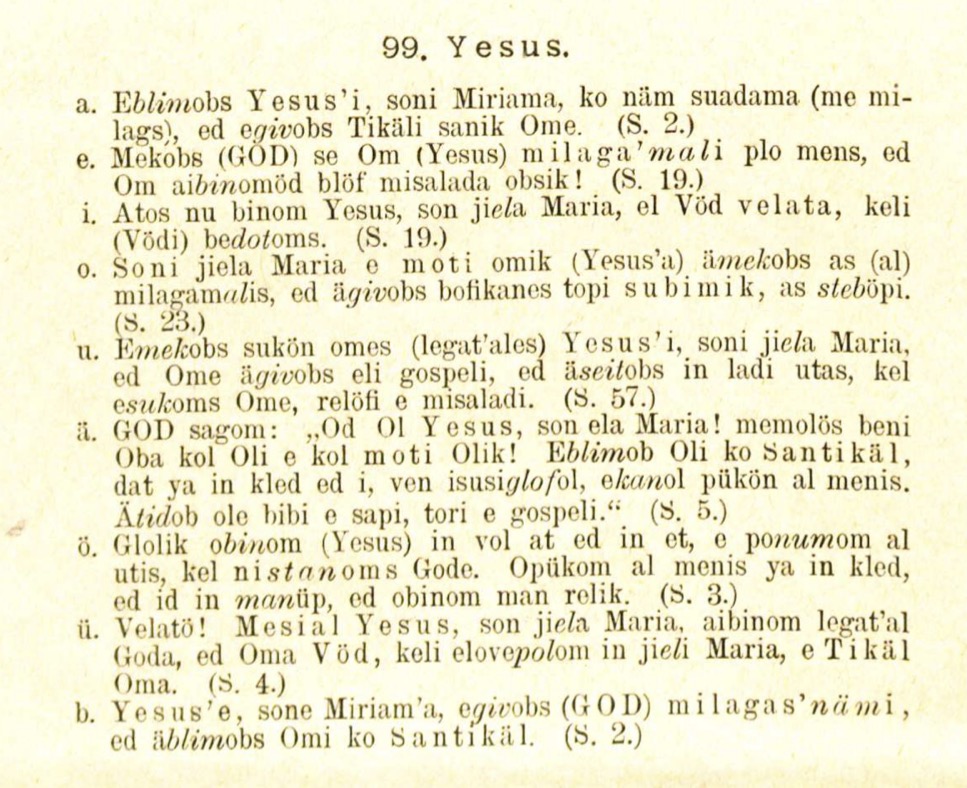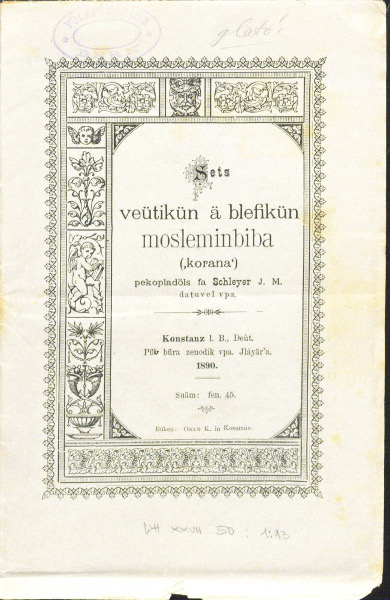In 1890, in the Southern German city of Konstanz, a booklet comprising a collection of excerpts from the Qur’an into the ‘world language’ Volapük was published. It is a fascinating document that gives us insight into the position of the Qur’an in nineteenth-century Europe, and also of contemporaneous perspectives on language, language planning, literature and translation.
Sold at the moderate price of 45 pfennig, the booklet, which contained fourteen pages of text, was entitled Sets veütikün ä blefikün mosleminbiba (‘korana’) or ‘The most important and concise sentences from the Muslim Bible (“Qur’an”)’. The translator was none other than the Catholic priest Johann Martin Schleyer (1831–1912), the inventor (‘datuvel’) of Volapük (from vol = ‘world’ and pük = ‘language’).

Schleyer came up with the idea for creating his language in 1878, aiming to produce a tool that would remove all barriers to communication throughout the world, later captured in the slogan ‘Menade bal püki bal’ (‘One language for one mankind’). Based on his knowledge of a wide variety of languages (which apparently, however, did not include Arabic), he developed a linguistic system based on monosyllabic roots, inspired by German, English, French, Italian, Spanish and Russian, from which all of Volapük’s words were derived. Volapük had a complex but regular grammar and was designed to be phonetically easy; for example, Schleyer tried to avoid the phoneme ‘r’ in order to make the language accessible to Chinese speakers. On the other hand, he was an ardent advocate of umlauts (ä, ö, ü) which, as a consequence, featured heavily in Volapük. Within a decade, it had become the most successful constructed auxiliary language ever, and probably only the second, after the less widespread Solresol, that found a transregional community of speakers. In the 1880s, at least two hundred Volapük clubs formed, mostly in Europe, although there were some in Asia and North America as well.

Why did Schleyer translate excerpts of the Qur’an into Volapük? Clearly, most Volapük speakers who wanted to learn about the contents of the Qur’an would have found it easier to do so in their first language. But translations into Volapük fulfilled purposes other than conveying information. Above all, they served as teaching and learning aids for the new language. Many members of the Volapük community communicated through letters and newspapers in Volapük, and the latter often contained translation samples designed to demonstrate how the language was supposed to be used. Translations, for Schleyer, undoubtedly also helped develop the vocabulary of his language. And finally, they functioned as a means of demonstrating the usefulness of the language and its capacity to produce intelligible text beyond the barest everyday needs. To achieve this purpose, Schleyer wrote a number of original collections of aphorisms and poems, but he also translated longer texts, predominantly religious works. Of course, being a priest, Schleyer had an affinity to scripture, but there was a more fundamental reason for his choice of texts for translation.
One of the first translations into Volapük was the Lord’s Prayer (1880); there followed a collection of excerpts from the New Testament (1887) and the First Epistle of John (1888). An Italian member of the community also translated the first canto of Dante’s Divine Comedy (1889). In 1890, the ‘Muslim Bible,’ namely, the Qur’an, followed. These choices are significant because, in nineteenth-century Europe, the predominant paradigm was that real languages – official, standardized, serious languages, as opposed to dialects – had to have literatures and, above all, scriptures. This is why the rise of vernacular languages in Europe in the early modern period had begun with the printing of Biblical translations. For Volapük to claim the status of a serious language, it needed both ‘high literature’, by authors such as Dante, and scripture. And, in the same vein, for it to claim the status of a universal language, it needed more than just Christian texts. Schleyer undoubtedly chose the Qur’an to help fulfil that purpose: translating it helped enhance Volapük’s claim to universality.
However, neither Schleyer nor anyone else in the Volapük community had the capacity to translate the entire New Testament or the entire Qur’an. Instead, Schleyer created a new genre of text specifically for Volapük: the genre of ‘the one hundred most important’ sentences, segments or topics. For example, he published his poetry as a set entitled ‘the first hundred’, and did the same with ‘the shortest and most meaningful sentences’ of the New Testament; his excerpts from the Qur’an, too, are arranged in exactly a hundred topics, each containing either a single or a few – according to the title page, the ‘most important’ but also the ‘most concise’ ones. He reached the required number partly by adopting many vague or redundant topics. For example, he has separate sections for ‘the grace of God’, ‘the mercy of God’ and ‘God’s love’.

When it comes to the translation process, Schleyer’s focus was clearly exclusively on meaning and on the most efficient way of transmitting it, as well as his language’s capacity to do so. He was not interested in narrative, in emotion or in aesthetics. While a focus on content over rhetoric is not uncommon at all in Qur’an translation, this is usually due to the translator’s idea of the Arabic Qur’an as an inimitable text. But, in Schleyer’s case, it has nothing to do with his view of the Qur’an but instead reflects his notion of language as a tool to accurately convey a meaning. And the more standardized and functional the tool is, the better.
For example, in his section on ‘hell’ (‘höl’), he presents a translation of Q 82:13–14:
إِنَّ ٱلْأَبْرَارَ لَفِى نَعِيمٍۢ
وَإِنَّ ٱلْفُجَّارَ لَفِى جَحِيمٍۢ
Inna l-abrāra la-fī naʿīm
wa-inna l-fujjāra la-fī jaḥīm
Due to its rhythm and rhyme, this segment is highly expressive in the Arabic Qur’an. However, Schleyer limits himself to conveying the bare meaning: ‘Cödikans okömoms in paladi vonik; abu klimidunels in höli.’ (‘The just people will come into a delightful paradise; the criminals, on the other hand, into hell.’) As in this example, all the segments he translates are consistently very brief, free of flavor and detail, and without an aesthetic impact; the result reads more like a manual than scripture.

Two further aspects of his translation methodology are noteworthy. First, the concept of the division of suras into ‘verses’ (āyāt) eluded Schleyer. Nineteenth-century Qur’an translations into Western European languages did not usually contain verse markers, let alone verse numbers. For Schleyer, the sura was one long continuous text consisting of sentences from which he picked some that suited his purpose. The sentence, not the verse, was the unit of translation. Some of his segments therefore only comprise a small part of a single verse, while others cut across verses.
Second, his translation was without any doubt exclusively based on the – rather mediocre – German Qur’an translation by Ludwig Ullmann (1840), as opposed to the original Arabic text. Schleyer translates Ullmann’s text word for word, and the fact that this is even possible without any shifts in syntax tells us something about the inherent Germanness of Volapük. Schleyer even imitates the word composition of Ullmann’s German usage, constructing compound verbs in Volapük where the stem would completely suffice to convey the meaning. E.g., he renders ‘transporting’ – ‘übertragen’ in German – as ‘overcarrying’ (‘ovepolön’) when the root verb ‘polön’, denoting ‘to carry’, would have been enough. He also copies Ullmann’s mistakes, for example when he translates raʾfa in Q 57:27 as ‘relöf’ (‘piety’) from Ullmann’s ‘Frömmigkeit’, rather than ‘compassion’ or ‘kindness’.


It is clear that Schleyer’s selection of sentences is governed by a theological agenda. For example, ‘Jesus’ is the second-most extensive topic in his booklet after ‘God’. He has a section on ‘Christians’ and even one on ‘idolatry’, but not on ‘Jews’. And he strategically chose the sentences he translated so that statements he would have found problematic were excluded.

For example, Q 4:171 starts with an exhortation directed at the ‘People of the Book’, continues with a statement on Jesus, and ends with a polemic against Christian doctrine:
‘People of the Book, do not go to excess in your religion, and do not say anything about God except the truth: the Messiah, Jesus, son of Mary, was a messenger of God, His word, conveyed to Mary, and a spirit from Him. So believe in God and His messengers and do not speak of a ‘Trinity’; stop, for your own good. God is only one God, Glory be to him. He is far above having a son …’
Schleyer only translated the middle part of this verse: ‘Truly! The Messiah Jesus, son of Mary, is a messenger of God, and His Word, which He has transferred unto Mary, and His Spirit.’ (‘Velatö! Mesial Yesus, son jiela Maria, aibinom legat’al Goda, ed Oma Vöd, keli elovepolom in jieli Maria, e Tikäl Oma.’) Read this way, the Qur’anic segment appears to be a confirmation of Jesus’ status, rather than a critique of Christian beliefs.
While this could theoretically be justified by Schleyer’s method of selecting only single sentences from Ullmann’s text, rather than thematic units, Schleyer also does not hesitate to cut Ullmann’s sentences short in order to omit certain statements. For example, his translation of Q 41:33 reads as follows:
‘Who could use a more beautiful language than the one who invites humans to God and acts with integrity?’ (‘Kim ba gebom püki jönikum, ka ut, kel vüdom menis al Godi, e dunom rito?’)
However, the Qur’anic verse does not end here, nor does the sentence in Ullmann’s translation; it goes ‘Who could use a more beautiful language than the one who invites humans to God and acts with integrity and says: I am a Muslim?’ (‘… und sagt: ich bin Moslem?’) The reason for the strategic omissions on Schleyer’s part is obvious. He wanted to translate the Qur’an on the basis that it is a scripture, to enhance the universality of Volapük’s claim, but at the same time he was loath to acknowledge the Qur’an’s polemics against Christian beliefs or include anything that could be understood as an affirmation of the superiority of Islam.
At the time Schleyer published his booklet of translated excerpts from the Qur’an, Volapük was already in decline: the community was starting to fall apart, in part over Schleyer’s refusal to accept proposals for changes made by the community. These included the abolition of umlauts to make the language more attractive to Americans, who tended to make fun of it. Schleyer, however, felt that a language needed umlauts to sound pleasant. This was his hill to die on, and unfortunately, he took his language along with him. Many Volapükists defected to Esperanto, which was easier to learn and more intuitive (even though Schleyer never tired of attacking the language for being ugly and including ‘unnecessary’ phonemes while dispensing with his beloved umlauts). However, as the linguist Arika Okrent points out in her article ‘Trüth, Beaüty, and Volapük’, the most important factor behind the demise of Volapük was probably ‘that the chances of any artificial language gaining a following are slim to none. There were hundreds of invented languages that came before Volapük and hundreds that came after, and almost no one has heard of any of them.’ Today, the acquisition of Volapük is a hobby shared by few – but the language does have its own Wikipedia, or rather, ‘Vükiped’.
Schleyer’s version of the ‘Mosleminbib’ was clearly not distributed widely, and today only a handful of libraries in Germany, the Netherlands and Switzerland hold copies. Yet its position at the nexus of language, literature and religion tells us something about the functions Qur’an translations may assume. Clearly Schleyer had a nineteenth-century mentality of limitless faith in human progress. He believed that universal communication could be engineered and that the scriptures of world religions could be categorized by chunks of meaning presented in sets of a hundred. While this approach is (hopefully) outdated, the use of the Qur’an in order to enhance the status of a language is nowadays more common than ever. In contrast to the late nineteenth century, today it is typically Muslim institutions and Islamic publishers who undertake such projects, and their aim is twofold: they not only want to enhance the status of marginalized languages by translating the Qur’an into them, but they also want to underline the universality of the Qur’an’s message by presenting it in ever more unlikely languages. This is an objective that Schleyer, as a Catholic priest, could not share. But as far as the translation of the Qur’an into unlikely languages is concerned, he was undeniably quite successful.
Johanna Pink
